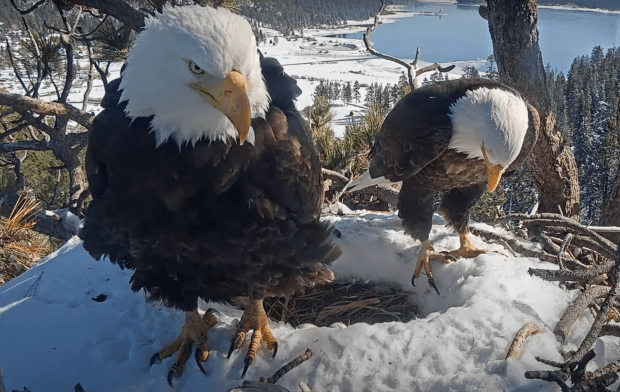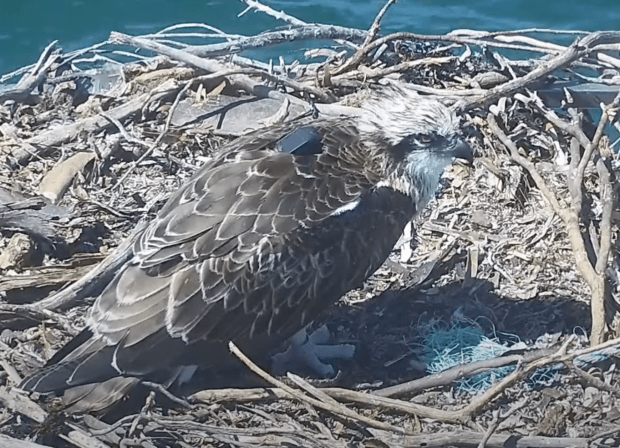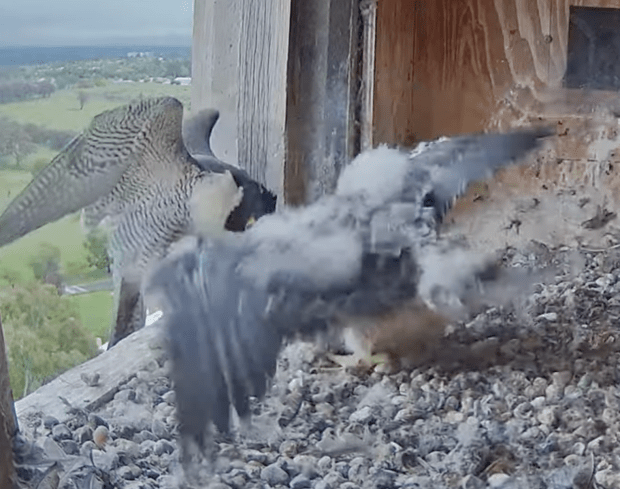23 April 2023
Good Morning Everyone,
I hope that each of you managed to get outside and really appreciate all the joy and wonder that nature provides us on Earth Day. For Bird World, it was a day of mixed blessings and sadness. But…the kittens are meowing to be first today! They always bring joy and ‘A’ continually reminds me of the health benefits of pets. It is true!
The kittens were positively delighted that Mr Crow paid a visit to the deck yesterday. They watched him for the longest time as he decided between his cheesy dogs and peanuts. The dogs won out because he likes to dip the peanuts in the bird bath and as you can see, the water is frozen again. you can also notice that there is not a leaf yet – we are so in need of ‘green’.

Lewis continues his spell of sleeping upside down and twisting all over the ‘Big Dog Bed’.

They have both grown so much, like all the falcons and eaglets, and can now take over that entire big bed they share! Since 2 November they have been inseparable. When they are sleeping they have to be touching one another. It reminds me of just how traumatic the lives of the rescue kittens can be and how these two immediately sought the comfort of one another.


I want to start with a precious little eaglet at Decorah. What a sweetheart. This one just melts my heart for some reason…more than the others which are equally adorable.

Open wide!


The giggle of the day comes from Cal Falcons:

R4 seems to be doing much better. ‘H’ writes: “Prey deliveries were down yesterday, and the parents ate a large portion of the fish that they brought to the nest! R4 did not eat until late in the day, but ate quite enthusiastically. S/he even managed to scarf up some big pieces. At 18:25 R4 ate for approximately 9 minutes. And at 19:41, R4 ate for about 12-13 minutes fed by Rose. Rose and R4 ate that entire fish leaving nothing for R5. R5 was shorted on food yesterday, and ate for a total of about 10 minutes from 3 feedings. No worries though, R5 had eaten for about 61 minutes in 7 feedings on 4/21. I have one pic of R4 from 1833 near the end of the feeding from Ron. R4 ate a lot more a little over an hour later fed by Rose, but R4 simply would not pose for a decent picture!” This is very good news, indeed. ‘H’ mentions that banding is coming up at WRDC and they will definitely give R4 a good check to see if anything is of concern at that time.

Florence returned to the Captiva Osprey platform after an absence of 25 hours but Angu was not about. River freed one talon of DH18 but not the other nor its wing and then the pair have since gotten tangled again or so it appears. One of the eaglets from the Bald Canyon is missing and is presumed to have fallen off the nest in the Channel Islands. The nest is not far off the ground. Hopefully parents providing some food. Eaglet is 3 weeks old.

It is like a roller coaster ride. Meanwhile, Annie and Lou’s little ones are all over the scrape and amazing each of us by their antics. That little one is such a cutie. We are also waiting for the Decorah Goose…this will be exciting.
We will never know what happened but Florence returned to her eggs after 25 hours. It is highly unlikely they are viable but I thought that about Milda’s eggs also and they hatched. We will wait and hope with Florence and Angus.
It is currently 1600 and Angus has not returned to the nest. Oh, dear.


Angus has not been seen since 0955 Saturday morning – nearly 12 hours as I am writing Saturday night. There are intruders in the area as Flo has been alerting. There is a hole in one of the eggs nearest the camera and that it is egg 2 leaving only egg 3, according to the hat. It could just be debris. Sadly a single osprey parent cannot take care of nestlings alone – it is just a fact – if Angus does not return and the eggs hatch.

The call to spread the word about DH18 in distress – tangled in all that fishing line and nesting material – and who will surely die if not untangled – is getting some traction in the news outlets in Tennessee. Will all this attention get help to DH18? Gosh, we would sure hope so! It is a human interest story with Obey disappearing, River having to defend the nest against intruders while trying to raise and feed DH17 and DH18 after DH19 died.
UPDATE: Around 1504 River was able to free DH18’s talon after the feeding. The wing is still tangled. As of Sunday morning it appears that the situation is more distressful as both eaglets are now entangled, again.

This was reported by Deb Stecyk for Bald Eagles 101 Saturday evening:
· “We continue to keep DH18 and the Dale Hollow eagle family in our prayers as DH18 leg remains tangled up in fishing line (and carcass), which appears to be affecting the circulation in that leg/foot. On a positive note, the eaglet is alert, and its appetite is not impaired ![]() Some reports on FB indicate the AEF and FWS are watching this situation closely so hopefully help is on the way.”
Some reports on FB indicate the AEF and FWS are watching this situation closely so hopefully help is on the way.”
Poor Mother Goose woke up to a windy Saturday with light snow flakes.


We wait, rather impatiently.

Eggs still in tact Saturday at 2100. Mother Goose takes a break.

After dusk. Mother Goose has been pulling down off her breast today to keep the eggs warm and covered when she leaves and to make sure there is not any drafts when she is incubating.

The Iowa DNR has published an article on 8 Cool Things about Geese!
We are five days away from fledge watch at Moorings Park Osprey Park in Naples, Florida. Will it be Victor or Abby that flies first?

At 1658 Harry brought in the fourth fish of the day to Sally, Abby, and Victor. It was a Tilapia.

Wet eaglets at Pittsburgh-Hayes Saturday morning.


These two are getting their feathers now. Oh, they look like they are itchy.

It was a gorgeous sunny day on the Channel Islands Bald Eagle nests and we got a rare treat with Chase and Cholyn on the nest together with their little eaglet. Just imagine. They have been together for a long, long time – two decades!

Waiting for that second egg at Glacier Gardens for Liberty and Freedom.

Blue 33 and Maya have some lovely nesting material. Blue 33 has been cuddled up with his lady on and off during Saturday.

It is Saturday and that means that I am lurking while Ferris Akel is doing his live stream in upstate New York near Ithaca. He found five Mute Swans this morning. Gosh, they are beautiful.


There was also a Glossy Ibis at Montezuma as well. They are considered rare for the area and are gorgeous if you can catch the iridescence of their plumage.


There was a single Sandhill Crane in the area of the Glossy Ibis, also. Ferris told us that the red on the head of the Sandhill Crane is not feathers but skin. I had no idea. Thanks, Ferris!



In the fields they eat grain. Everyone, including Ferris, is wondering what they are foraging after here at Montezuma.


American Coots and Blue-winged Teals were paddling in the water.



A Shoveler.

I loved it when Ferris Akel said “Birds always have the right of way but, he wishes they would be more careful”. He also added that “at least they do not look at their phones when they cross the street”! Yeah, Ferris.

At the end of the evening, Ferris caught Arthur, all wet, up on Bradfield while Big Red keeps the eggs warm and dry on the nest. Dark and rainy.

Gracie Shepherd gives us a video of E21 and 22 soaring together in the thermals at Fort Myers. My goodness. It will not be long now til they soar. What a blessing this nest has been. The Es are 16 weeks old. They might be around for another week or a bit. What glorious eagles M15 raised.
The winds are really blowing at Ithaca. Big Red and Arthur are changing shifts and oh, goodness, they must have to hold on tight.



The heavy rain forecast for Ithaca began around 1630.

No worries for any of the Cal Falcons. That third hatch is a firecracker and it had a big crop today!


Iris blessed us by a visit to the Owl Pole today.

The falcons that use a nest instead of a scrape at the Baryczy Forest in Poland have three babies they feed. You can watch them in the video below.
Some great news coming out of Tampa.

A rescued eagle with a fish hook – so much fishing and so many lines and hooks and sinkers full of lead.

Sadly, as so many of you know, the fish have been on and off again at the Achieva Nest this week. There are either lots or few or none. The oldest is now gone into aggression mode again but, against Middle Bob now. Remember – there are always three difficult nests to watch: Achieva, Port Lincoln Ospreys, and Dale Hollow. Without exception. Every year unless it is a year of three males at PLO (2021).
The eaglets are 36 and 35 days old today.

My heart will hardly stay still. An enormous outbreak of Avian Flu is hitting The Gambia where many of European ospreys spend their winter and where the youngsters remain. This is tragic!

Thank you so much for being with me this morning. I am investigating a report that the group at Dale Hollow have applied for a federal grant for a new marina at the Moody Boat Dock on Dale Hollow Lake. Take care all. Send all your wishes to our nests today – the news is like a roller coaster.
Thank you to the following for their notes, videos, posts, and streaming cams that helped make up my blog this morning: ‘H’, ‘A’ Raptor Resource Group and Explore.org, WRDC, Gracie Shepherd and Raptors of the World, Heidi MGrue and Raptors of the World, Window to Wildlife, Decorah Goose Cam, Iowa DNR, Moorings Park Ospreys, Pittsburg-Hayes and PIX Cams, IWS and Explore.org, Glacier Gardens, LRWT, Ferris Akel Live Tour, Gracie Shepherd and SW Florida Eagle Cam, Cornell RTH, Cal Falcons, Montana Osprey Project, Sokol-D Baryczy, 10 Tampa Bay, Sydney Wells and Bald Eagle Live Nests and Cams, Achieva Credit Union and The Guardian.






































































































































































































